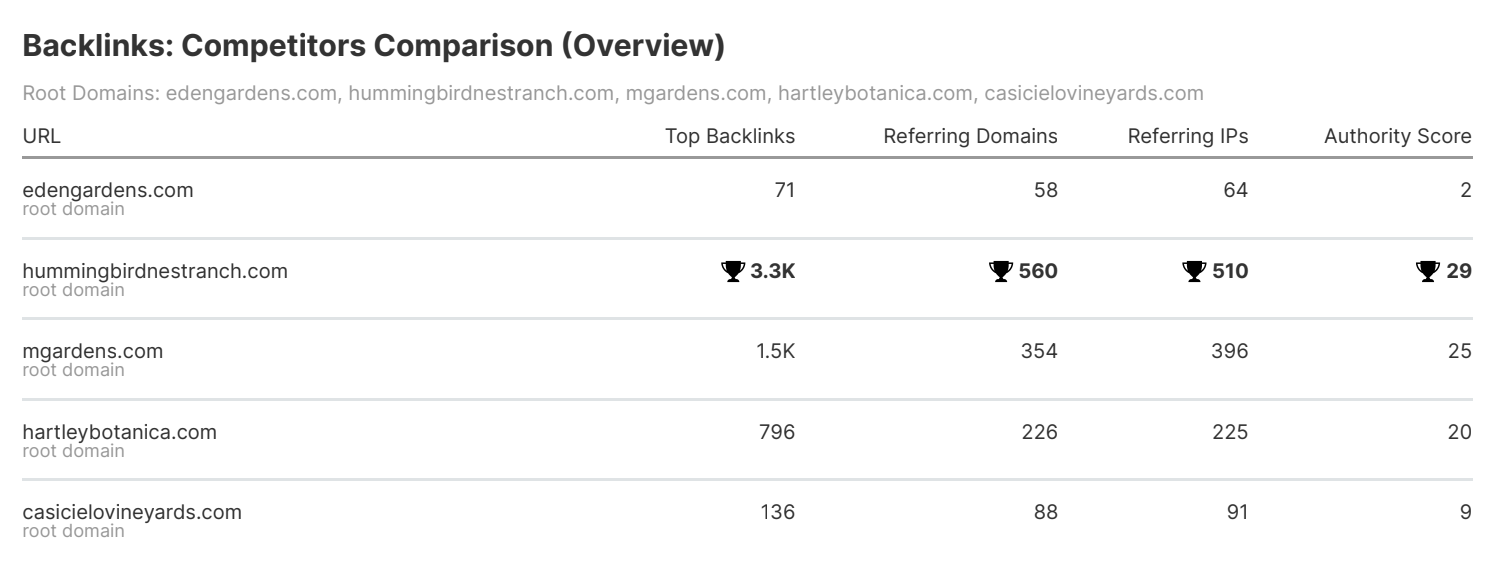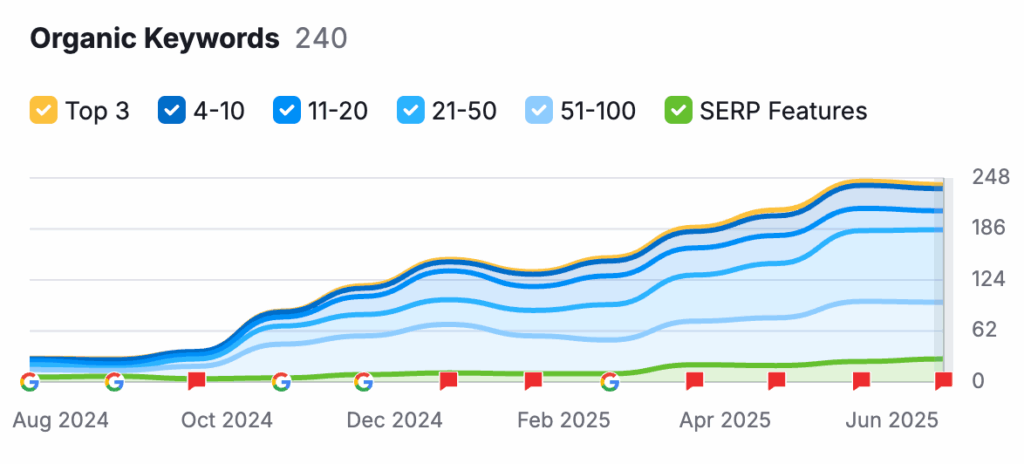You’ve optimized your title tags, fixed your meta descriptions, improved your site speed, and checked off every item on your SEO checklist. Or better yet – you got all of those SEO tasks done-for-you! But months later, you’re still asking yourself: “Why is my website not ranking?”
If this sounds familiar, you’re not alone in your frustration. The truth is, completing on-page and technical SEO optimization is just the foundation of your SEO strategy, not usually the finish line. While these initial optimizations are crucial for helping search engines understand your content, they don’t always guarantee rankings because of a few important factors.
So, let’s dive into why your website still isn’t ranking after optimization and what ongoing strategies you need to implement to see real results.
Table of Contents:
- The Foundation: On-Page & Technical SEO
- The Competition Factor: Understanding Keyword Difficulty
- Domain Authority: Building Trust with Google
- Content Relevance & Search Intent: Beyond Keywords
- Topical Authority: Becoming the Expert
- Real Client Examples: Different SEO Journeys
The Foundation: On-Page & Technical SEO
First off, your on-page and technical SEO work wasn’t wasted! These optimizations serve as the essential foundation that allows search engines to properly crawl, understand, and index your website.
According to Google’s official ranking systems guide, search engines use automated systems to analyze many factors across billions of web pages to deliver relevant results, and the main purpose of on-page and technical SEO is to make your website accessible and understandable to search engines. You’re essentially preparing your website to compete in search results.
Tip: Use Google Search Console to identify which pages are indexed. This is one of the most reliable sources of ranking and traffic information that is straight from Google. Sometimes external tools aren’t accurate and can cause a panic!
The Competition Factor: Understanding Keyword Difficulty
Sometimes your website isn’t ranking simply because you’re in an arena that’s competitive for your current authority level. Local and niche-specific terms are typically less competitive than broad, global keywords.
There are a few important factors that go into how your website will perform for different queries:
- Search volume for your target keywords
- Domain authority of currently ranking pages
- Content quality and depth of top-ranking pages
- Number and quality of backlinks to competing pages
If you’re a new business targeting a highly competitive term, you may not see results until you gain authority to compete with other sites. While going after lower competition keywords is often the preference, we do believe there are times when a higher competition keyword can pay off, if it’s the most relevant and the business is committed to working for it!
Let’s go through those factors and what you can do to improve your own metrics to increase your chances of ranking higher!

Domain Authority: Building Trust with Google
One of the most critical factors affecting your rankings is domain authority, which essentially comes down to how much Google trusts your website.
Google wants to show users high-quality, informative, and relevant content, and they determine this partly through authority signals. Backlinks, which are links from other websites to yours, act like votes of confidence. The more high-quality backlinks you have, the more trust you earn with Google. When authoritative websites in your industry link to your content, they’re essentially vouching for your credibility.
Think of it like influencer marketing. If a respected expert in your field mentions your business, you instantly gain credibility by association. The same principle applies to backlinks from high-authority websites.
Assessing Your Domain Authority
To understand if authority is limiting your rankings, you need to:
- Check your domain authority score using this free tool
- Analyze your competitors who are ranking for your target keywords
- Compare authority metrics to see where you stand

More often than not, websites ranking on the first page of Google have significantly higher domain authority than sites that aren’t ranking well. This is especially true for competitive keywords in established industries.
Building Authority Through Quality Backlinks
Here’s how you can build these backlinks:
- Identify relevant websites in your industry for outreach (or follow your Aligned SEO backlink strategy 😉). These could be blogs, publications, business directories, industry professionals, and more!
- Create linkable assets (research studies, comprehensive guides, tools) and share with other niche-adjacent industry professionals
- Build relationships with industry publications and influencers
- If you discover a mention of your business online with no link, ask for one!
Remember, it’s not just about quantity! One high-quality backlink from an authoritative source can be more valuable than dozens of low-quality links.
Content Relevance
Google has become incredibly sophisticated at understanding not just what your content says, but whether it truly satisfies what searchers are looking for.
Creating Comprehensive, Helpful Content
As we learned above, Google wants to show relevant, helpful content to its users. Longer, comprehensive content often performs better than shorter articles because it can cover topics more thoroughly.
However, length shouldn’t be the main focus. Your content should:
- Answer the user’s complete question, not just touch on keywords
- Provide unique insights or perspectives that aren’t found elsewhere
- Include relevant examples, data, or case studies when appropriate
- Be structured for easy reading with clear headings and formatting
Topical Authority: Becoming the Expert
One of the most overlooked factors in SEO success is topical authority, which is how well Google understands that your website is an expert resource in your specific niche.
When Google sees multiple pages on your website covering related topics in depth, it begins to recognize your site as an authority in that subject area. In other words, if you have existing pages or blogs with valuable content about your main services, location, and industry, you’re may see rankings much quicker than a site with no helpful content on the subject.
For example, if you have an interior design business and have helpful, in-depth articles all about interior design projects, different design styles and trends, and interior design tips, Google can more easily understand that your website is a authoritative in interior design, making it more likely to rank when you optimize your main pages for those terms!
Building Topical Authority
To establish topical authority:
- Develop topic clusters around your main service areas and plan content that addresses user questions throughout the buyer’s journey (or follow your Aligned SEO content strategy 😉)
- Write supporting articles that dive deep into specific subtopics
- Link related content together to show topical relationships
- Publish relevant, helpful content over time
This approach takes patience, but the results compound over time. Websites with strong topical authority often see faster indexing, better rankings, and increased organic traffic as they add new content.
At Aligned SEO, we provide our clients with a content strategy, providing comprehensive topic clusters that will help establish topical authority. Following the content strategy intentionally is a key piece to a successful SEO strategy. We’ve noticed that the websites who complete an SEO overhaul, and stick with us for monthly blog and SEO management tend to grow faster than those that see SEO as a one-and-done service.

This client completed done-for-you SEO services, and has been enrolled in our management services for months. This ensures consistency in posting, fixing technical issues that pop up, and maintaining their local SEO.
Timeline Expectations
SEO is an ongoing process, not a one-time project. Google continuously updates and improves their ranking systems through testing and evaluation, which means successful SEO requires ongoing adaptation and optimization. Google is not the enemy though! Google seeks to match its users with the best possible results, and you want to be one of them!
Most SEO efforts take 3-6 months to show significant results, and building substantial authority can take 6-12 months or longer. For newly optimized sites, or new websites, this can sometimes take even more time and effort. This timeline depends on your industry competitiveness, current domain authority, and the consistency of your efforts.
Real Client Examples: Different SEO Journeys
Every website’s SEO journey is unique, and understanding different scenarios can help set realistic expectations for your own results.
Case Study 1: Taylor White Photography – The Perfect Storm
Sometimes multiple factors align to create faster ranking success. My own photography business ranked on page 1 within weeks after optimization, but this wasn’t just due to the technical work. Several pre-existing factors contributed to this success:
Domain Age Advantage: I had owned my website for several years before optimizing it. While domain age alone doesn’t guarantee rankings, an established domain with consistent content history can have advantages over brand-new websites.
Unintentional Authority Building: Years before I understood SEO, I regularly submitted my photography work to online magazines, blogs, and wedding publications. My goal was simple – I wanted to call myself a “published, award-winning photographer” for credibility with potential clients. I was also featured in business blogs and industry publications.
What I didn’t realize at the time was that these features were creating high-quality backlinks from authoritative websites in my industry. By the time I optimized my website, I already had strong domain authority from these editorial mentions and features.
Low Competition Market: My geographic area had relatively low competition for wedding photography keywords. Combined with my higher domain authority from existing backlinks, this made it easier to rank for targeted local keywords.
This combination of domain age, existing authority, and low competition created ideal conditions for quick ranking success after optimization.
Case Study 2: Minnesota Photographer – The Typical Journey
Not everyone starts with these advantages, and that’s perfectly normal. A Minnesota photographer I worked with represents a more typical SEO journey:
Starting Point: She had been in business for several years but her website had minimal domain authority. Her previous website wasn’t optimized and she had very few quality backlinks. Competition was higher in her area for target keywords.
Initial Results: Within a few weeks of completing her SEO optimization, she started appearing in search results around page 6 for her target keywords. However, rankings on page 6 don’t generate meaningful traffic or leads.
The Patience Phase: For the first couple of months, she saw minimal clicks to her website despite being indexed and starting to rank. This is common – being found and getting traffic are two different milestones.
Gradual Progress: Over several months, she gradually moved from page 6 to page 5, and eventually to pages 1 and 2 for her target keywords. This progression took approximately 6-8 months of consistent effort.
Ongoing Strategy: After the initial optimization was complete, she committed to ongoing SEO efforts including pursuing citations and backlinks, and publishing blog content regularly that served her future clients.
Results: These ongoing efforts significantly boosted her domain authority and search visibility. She began receiving consistent leads through her website and saw measurable increases in organic traffic.
Getting Results with Comprehensive SEO Strategy
The reality is that successful SEO in 2025 requires more than just on-site and technical optimization. It demands a holistic approach that includes authority building, content strategy, and ongoing optimization.
Your initial SEO optimization work created the foundation that makes everything else possible. Now it’s time to build upon that foundation to establish your domain and topical authority!
The good news is that when you combine solid technical foundations with ongoing authority building and content strategy, the results compound over time. Websites that invest in comprehensive SEO strategies often see exponential growth in organic traffic and search visibility.
Your SEO optimization wasn’t wasted; it was the essential first step. Now it’s time to take the next steps toward building the authority and relevance that will drive long-term ranking success.

I know how it feels to be stretched thin, trying to juggle all the things – marketing, sales, content creation, all while trying to serve your clients well. I’m here to simplify your life and handle all things SEO!
With years of experience helping service providers and creatives get found online, plus four websites of my own—including my photography business that generates all its leads from Google—I know how to turn your website into a client magnet. I’m the SEO expert you can trust to make your business visible.
Meet Taylor, your new SEO bestie
about your certified seo specialist
© Aligned SEO 2025 | all rights reserved | Terms and conditions | Privacy Policy
9620 NE Tanasbourne Dr., Suite 300, Hillsboro, OR 97124
E: taylor@alignedseo.com
Helping small businesses and service providers grow their online presence with done-for-you SEO services. We simplify the path to better visibility, more traffic, and sustainable growth, so you can focus on what you love.
to top